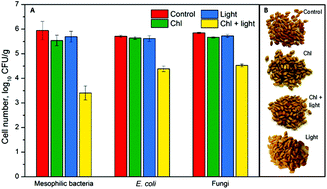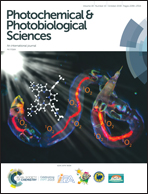Toward better microbial safety of wheat sprouts: chlorophyllin-based photosensitization of seeds
Abstract
Sprouted seeds are gaining popularity worldwide due to their high nutritional value. At the same time, they are among the most highly contaminated fresh produce and have been recognized as the primary source of food-borne pathogens, such as E. coli O157 and harmful microfungi. The antifungal and antibacterial properties of chlorophyllin-based photosensitization in vitro together with successful application of this treatment for microbial control in wheat sprouts have been investigated. First, we examined the antimicrobial efficiency of chlorophyllin (Chl, 1.5 × 10−5–5 × 10−3 M) activated in vitro by visible light (405 nm, radiant exposure: 18 J cm−2) against the food-borne pathogen Escherichia coli and plant pathogen Fusarium oxysporum. Results revealed that this treatment (1.5 × 10−5 M Chl, incubation time 1 h, 405 nm, radiant exposure: 18 J cm−2) can reduce the E. coli population by 95%. Moreover, at higher chlorophyllin concentrations (5 × 10−4–5 × 10−3 M Chl), it is possible to delay the growth of F. oxysporum by 51–74%. The decontamination of wheat seeds by chlorophyllin-based photosensitization (5 × 10−4 M Chl, 405 nm, radiant exposure: 18 J cm−2) remarkably reduced the viability of surface-attached mesophilic bacteria (∼2.5log CFU g−1), E. coli (∼1.5log CFU g−1) and yeasts/fungi (∼1.5log CFU g−1). Moreover, SEM images confirmed that this treatment did not damage the grain surface microstructure. Most importantly, Chl-based photosensitization did not reduce the seed germination rate or seedling growth and had no impact on the visual qualities of sprouts. In conclusion, the chlorophyllin-based photosensitization treatment, being nonthermal, environmentally friendly and cost-effective, has huge potential for microbial control of highly contaminated germinated wheat sprouts and seeds used to produce sprouts, especially in organic farming.

- This article is part of the themed collection: New and innovative applications of Photodynamic Inactivation of microorganisms


 Please wait while we load your content...
Please wait while we load your content...